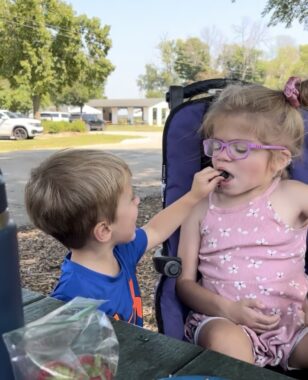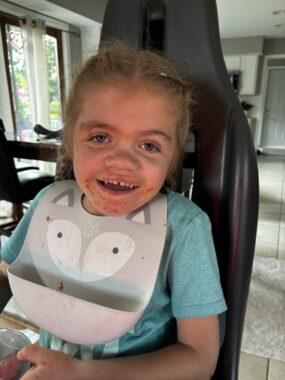Feeding our toddler with Sanfilippo syndrome can be stressful
We must keep a close eye on Liv's diet and nutrition

Many parents find feeding a toddler challenging, resulting in frustrating mealtimes. At this age, kids can be very picky and easily distracted.
For our 5-year-old daughter, Liv, who has Sanfilippo syndrome, almost every meal is a struggle. As a nearly full-time stay-at-home mom, I tend to organize and prepare most meals, but my husband and I both help feed Liv.
It’s hard to ensure she consumes a variety of nutritious options three times a day. At some meals, Liv self-feeds and seems interested in her food. Other times, she wants nothing to do with it, and we find ourselves placing food into her cheeks.

Liv’s brother, Liam, feeds her blueberries. (Photo by Erin Stoop)
As Sanfilippo progresses, children may become unable to eat by mouth. This often happens around age 10 but can vary, as the disease affects every child differently. Multiple factors may contribute to their reduced ability to eat orally, including thickened oral tissues, specifically the tongue; forgetting how to use their hands and utensils; and brain damage that makes it hard to remember how to chew and swallow.
We’ve spent time with several kids around Liv’s age who also have Sanfilippo, and each time, I was blown away by how well they ate. They were messy, sure, but they wanted to eat solids and couldn’t get the food in their mouths fast enough.
This has never been the case with Liv. While she loves yogurt pouches and chocolate milk from a sippy cup, she has never liked eating solids. My husband or I have to place food in her cheek more than half the time.
In August, we attended the National MPS Society‘s annual conference and met other Sanfilippo families. Several who are further along in the journey than we are encouraged us to pursue a feeding tube for Liv sooner rather than later. They all said they regretted not doing it for their child sooner.
This was eye-opening for us. It doesn’t mean we’ll pursue a feeding tube today, but we’ll keep the idea on our radar and look into it at the first sign that Liv’s diet isn’t adequate.

Liv smiles after a messy lunch. (Photo by Erin Stoop)
This month, we met with a dietitian and a gastroenterologist to discuss our concerns about her not eating many solid foods. We were reassured that because Liv drinks six or more cups of 2% milk daily, three with Carnation powder, she’s getting more than enough nutrition to maintain her weight and continue growing.
This was a large weight off our shoulders. Moving forward, we can continue presenting solids to Liv, but if she isn’t interested, we won’t stress ourselves out trying to place every piece into her cheek. We will allow her to pleasure-feed the solids she wants.
We also plan to meet with a speech and swallow therapist in the coming months. Many kids with Sanfilippo aspirate, so we want to ensure that Liv is not aspirating liquids and increasing her risk of infection.
Everything with Sanfilippo is hard, but one of the most frustrating parts is its ever-changing nature. As soon as we think we have a handle on things, the disease progresses. Liv’s diet will likely always be in flux, so we’ll do our best to prepare and think ahead to ensure her safety and well-being.
Note: Sanfilippo News is strictly a news and information website about the syndrome. It does not provide medical advice, diagnosis, or treatment. This content is not intended to be a substitute for professional medical advice, diagnosis, or treatment. Always seek the advice of your physician or other qualified health provider with any questions you may have regarding a medical condition. Never disregard professional medical advice or delay in seeking it because of something you have read on this website. The opinions expressed in this column are not those of Sanfilippo News or its parent company, Bionews, and are intended to spark discussion about issues pertaining to Sanfilippo syndrome.







Leave a comment
Fill in the required fields to post. Your email address will not be published.